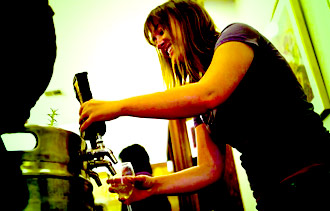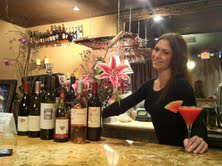Blog Archives
Set It and Forget It! Plant Garlic Now, Enjoy It Next Summer

image: lowjumpingfrog
This just in from my lunch break: I put in next summer’s garlic crop. You can too! Here’s what you need:
- Garlic
- Digging tool
In most of North America, now’s the time to plant garlic and other bulbs. They will establish some roots before the ground freezes, then sleep all winter to emerge in spring.
What kind of garlic should I plant?
Obviously, you’ll want to plant organic. Not only is it better for you and for the soil, but non-organic garlic is often treated with an anti-sprouting agent that will keep it from growing in the first place.
I recommend seeking out an heirloom variety, ideally a hardneck “true” garlic. Though it can be tempting to pick up elephant garlic for its huge bulbs, elephant garlic is actually more closely related to the onion, and can have trouble if you plant it too late in the fall. True garlic has smaller cloves, but they’re much more potent. For my garlic patch, I picked a Chesnok Red that I picked up from a local permaculture nursery.
Where should I plant it?
Someplace it’ll have good sun, in well-draining soil. You don’t want your bulbs to rot.
If you live someplace that gets very cold with little snow cover, mulch it with straw after the first hard frost. Otherwise, it should survive the winter just fine.
How much should I plant?
Are you kidding? Garlic is delicious. Plant as much as you can. Bury one clove of garlic every foot or so (advice varies on this, but one foot seems a safe distance even for hungry bulbs). Each clove should divide into a new bulb, and will flower in early summer.
How do I plant it?
Dig a hole and put a clove of garlic in, pointy side up. For small cloves, put them about one inch deep — that is, they should have an inch of dirt over their heads. Bigger bulbs like elephant garlic should go deeper, up to 3 inches.
After you’ve planted it, water it in by drenching the soil completely.
Now, you wait. Begin watering in the spring, and you’ll harvest your garlic crop in the summer.
And that’s garlic, and that’s how I spent my lunch break! Speaking of which: Got a few cloves left over? Whip up a batch of organic bistro garlic fries.
Article excerpted from www.organicauthority.com
It’s not hard to plant the garlic and we should start to plant it at our garden. This will be one way to save money and we will have a healthy exercise too by planting the garlic. Once garlic crops have been harvested, don’t forget to try out the organic bistro garlic fries recipe.
What does it mean to be a Green Designer?
To be a green designer means to think about our environment and to practice sustainable design. This includes using non-toxic recyclable materials and saving on energy and resources where we can. The ultimate aim of practicing sustainable design, is to reduce waste, use as little resources as possible, and the resources that are used, should be unharmful to our environment and re-usable.
Why should I go green?
As a graphic designer, your job is to produce creative ideas to promote your client’s message effectively. By promoting a greener image, you are adding value to your relationship with the client. Consider that consumers have never decided against a product because it is green, but they have and will decide not to buy it if it isn’t. In fact, 82% of consumers are focused on buying green products and services. Customers are becoming more drawn to going paperless, recycled products, bio-degradable products and low emission products.
Companies that are supporting the eco-friendly movement are also seeing increasing numbers in their sales. Many companies are opting for the ‘greener’ option not only because they are contributing to a better, healthier Earth, but because it saves on costs:
- Less print costs
- Less shipping costs
- Less energy costs
How can I practice green design?
By creating a greener image, we are creating awareness of our environment. By creating a greener product, we are taking the step of saving it.
The first step is to become aware as the designer. You’ve heard about the three R’s and why we should be doing it, everyone has; but has it become something you think about daily?
Start with your own surroundings:
- Are you using energy efficient light bulbs?
- Are you turning off your pc/appliances when you’re finished?
- Are you using more paper than needed?
- Are you printing more than necessary?
- Can you reduce your own waste materials?
- Do you have recycling methods in place?
The next step is to think about how your work is impacting the environment. Did you know that for every ton of paper that is recycled, the following is saved: 7,000 gallons of water; 380 gallons of oil; and enough electricity to power an average house for six months.
When you receive a project, the importance of how it may effect our environment should be something considered in every step of the planning.
Factors to consider include:
- Are the materials you’re using recyclable?
- Are the materials coming from somewhere nearby?
- Are the materials non-toxic?
- Can you use less materials?
- Can scrap materials be used?
- What will happen when the user no longer needs this piece?
- If printing, are the inks vegetable-based or soy-based
There are so many helpful resources out there supporting graphic designers to make the commitment. If you’d like to make a pledge please visit : designcanchange.org
Re-nourish is my favorite site of all. It includes fantastic tools to help, including a project calculator, paper finder and green printer finder. It also includes standards on design sustainability and includes the best case studies on companies that have gone green. Another inspiring and helpful resource is the ‘big book of green design’, which shows numerous examples of projects and explains why they are green.
Don’t be frightened to think of green design as being limited… it’s just another opportunity to think outside the box and get creative!
Article excerpted from www.creativeoverflow.net
Firecrackers go green this Diwali
Diwali promises to be truly a festival of lights this year with an increasing number of environmentally-conscious people in the metros, especially in the national capital, opting for eco-friendly and smokeless firecrackers.
 Made of recycled paper, eco-friendly crackers do not contain as much chemicals as conventional firecrackers, and thus emit less smoke and noise. “Unlike the normal cracker making method, the eco-friendly crackers are based on vacuum combustion method. These crackers produce colourful sparks with a considerable sound and less smoke,” A. Muthu, a fireworks dealer in Sivakasi, Tamil Nadu, told IANS.
Made of recycled paper, eco-friendly crackers do not contain as much chemicals as conventional firecrackers, and thus emit less smoke and noise. “Unlike the normal cracker making method, the eco-friendly crackers are based on vacuum combustion method. These crackers produce colourful sparks with a considerable sound and less smoke,” A. Muthu, a fireworks dealer in Sivakasi, Tamil Nadu, told IANS.
“All the major metros demand eco-friendly crackers, while people in villages and small towns still prefer high-decibel crackers,” Muthu said. According to a recent survey by the Associated Chambers of Commerce and Industry of India (ASSOCHAM), Sivakasi, home to over 9,500 firecracker factories, produces almost the entire fireworks output of India.
It has increased production of smokeless firecrackers due to rising demand. “With demand increasing for environment-friendly crackers, we are producing more of them by adding less of chemicals like sulphur and potassium nitrate,” another dealer S. Anbumani said.
He said Delhi and Kolkata lead in the purchase of these varieties. “There is definitely a shift in choice among the customers. Earlier, they used to prefer high-decibel crackers. Now, over 55 percent go for eco-crackers, which do not cause much noise pollution,” said Piyush Sharma, a shopkeeper in Sadar Bazar in Delhi.
Costing from Rs.15 to Rs.3,500, these crackers are also less expensive than the traditional ones. “The ‘magic whip’, a long red-coloured string which doesn’t emit smoke, whistling sparkler and crackling bullet — a rocket which produces a colourful explosion, are good option for kids,” another shopkeeper Shavi Aggarwal said.
And for people who want to have a blast on Diwali, these varities are great for having fun without feeling guilty about harming the environment. “Diwali is known for fireworks, it is not complete without bursting crackers. So the best way is to opt for eco-friendly crackers and save the environment without dampening the festive mood,” said Akhilesh Gupta, a businessman.
Article excerpted from www.deccanherald.com
Firecrackers is going green too? That’s a great news to everyone who celebrate in this festive season. Anyway, be sure to play safe with the fire. Have a fun Deepavali day ahead.
Tips for Finding Green Hotels
As I write this, I’m in a hotel room on the Vegas Strip, looking out my window at the construction site of what will be the largest green hotel in the world, set within MGM Mirage’s $7.4 billion City Center. The hotel is pursuing certification from the Leadership in Energy and Environmental Design (LEED) Green Building Rating System, which sets standards for environmentally sustainable construction. Among the measures it’s taking: recycling 80 percent of construction waste and building a monorail to the Bellagio. But if you check in when the hotel opens in 2009, you might not notice it’s green the property’s casino (not LEED certified) allows smoking.
What Does “Green” Mean?
Unless you stay in an eco-lodge, you’re not always likely to see a property’s efforts to reduce its impact on the environment. Sure, you might be asked to recycle towels and use a key card that controls your room’s lights and climate. But subtler measures, such as building with recycled materials and landscaping to use less water, aren’t so apparent.
You can look for some proof of certification, but dozens of countries, several U.S. states, and a number of industries have their own labeling programs with varying standards, so it’s difficult to know just how green your hotel really is. (See five of the most reputable programs at right.) To complicate this scenario, many properties are bypassing accreditation in favor of developing their own sustainability plans. The Willard InterContinental in Washington, D.C., for instance, uses renewable wind electricity and purchases organic food whenever possible.
What’s Next?
Eco-construction is a growing phenomenon. According to the U.S. Green Building Council, there are now 118 hotels that have registered for LEED certification. So far, only one hotel—the Gaia Napa Valley—has earned the Gold certificate (the second highest level). Striving to be the next property to get Gold (or perhaps Platinum, the highest LEED certification, which no hotel has yet achieved), the Proximity Hotel, in North Carolina, will use rooftop solar panels, install elevators that generate a portion of their own power, and use an air-exchange system to reduce its energy consumption. And LEED is expanding to international hotels. Easter Island’s Explora Rapa Nui, set to open in December, seeks to obtain Gold status.
What Can You Do?
Every property in T+L’s “Favorite Green Hotels” filled out an eco-questionnaire to ensure that they’re meeting high environmental standards. You can put the same questions to a hotel before booking: What has it done to reduce carbon emissions and waste?How does it conserve energy and water consumption?And does it have programs that support its community?You’ll be doing the environment a favor.
Article excerpted from www.travelandleisure.com
Pedestrian tunnel could ‘go green’

WIND-POWERED? … the pedestrian tunnel could ‘go green’.
Now the outdated tunnels are set for a major overhaul, which could include going carbon-neutral and being powered by a wind turbine.
Plans for the ambitious transport scheme – the first of its kind in the region – were announced at a meeting of Jarrow community area forum this week.
The scheme includes, the removal of the existing wooden escalators and the installation of new inclined lifts, similar to those operating near the Millennium Bridge in London.
A unit capable of carrying up to 26 passengers, plus bicycles and full-size scooters, would be fully glazed, allowing people to view much of the structure and workings of the historic river tunnels.
Cliff Jessett, project manager of the New Tyne Crossing, said: “We’re interested in energy generation and this could include creating power for the tunnels with a wind turbine, like the one at the Eco Centre, in Hebburn.
“The aim is to keep energy levels low and we are confident we can create a carbon-neutral listed structure.”
The tunnels have been subject to numerous breakdowns, with parts being very difficult to source for the 60-year-old transport link, which was granted Grade 11 listed status in 2000.
“Basically, the tunnels are looking ‘tired’ and are coming to end of their natural life, and need to be replaced,” Mr Jessett added.
The £6m conservation scheme approved last year by Tyne and Wear Integrated Transport Authority, will also include new lighting and CCTV systems, plus paving and tiling.
Work on the scheme could start either late this year or early 2012, dependent on planning permission and listed building consent.
Celebrations are also in the planning stages for the tunnels’ 60th anniversary in July.
Article excerpted from www.shieldsgazette.com












